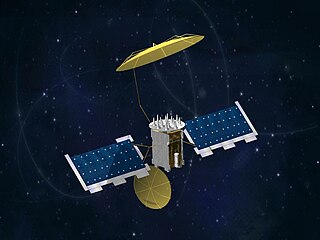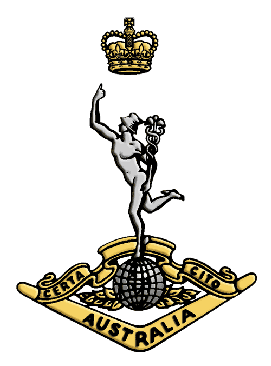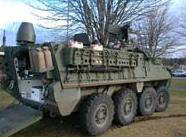
Skynet is a family of military communications satellites, now operated by Airbus Defence and Space on behalf of the United Kingdom's Ministry of Defence (MoD). They provide strategic and tactical communication services to the branches of the British Armed Forces, the British intelligence agencies, some UK government departments and agencies, and to allied governments. Since 2015 when Skynet coverage was extended eastward, and in conjunction with an Anik G1 satellite module over America, Skynet offers near global coverage.

The Royal Corps of Signals is one of the combat support arms of the British Army. Signals units are among the first into action, providing the battlefield communications and information systems essential to all operations. Royal Signals units provide the full telecommunications infrastructure for the Army wherever they operate in the world. The Corps has its own engineers, logistics experts and systems operators to run radio and area networks in the field. It is responsible for installing, maintaining and operating all types of telecommunications equipment and information systems, providing command support to commanders and their headquarters, and conducting electronic warfare against enemy communications.
The Allied Rapid Reaction Corps (ARRC) is a rapid reaction force maintained by NATO. It is capable of deploying a High Readiness Force (Land) Headquarters at short notice for operations and crisis response.

A military satellite is an artificial satellite used for a military purpose. The most common missions are intelligence gathering, navigation and military communications.

RAF Oakhanger is a Royal Air Force station in Hampshire split over three operational sites; with accommodation in nearby Bordon. The main site and operations centre is located near the village of Oakhanger, the two other sites being nearby. The parent station for administrative purposes was RAF Odiham.

The Joint Tactical Radio System (JTRS) aimed to replace existing radios in the American military with a single set of software-defined radios that could have new frequencies and modes (“waveforms”) added via upload, instead of requiring multiple radio types in ground vehicles, and using circuit board swaps in order to upgrade. JTRS has seen cost overruns and full program restructurings, along with cancellation of some parts of the program.

The Mobile User Objective System (MUOS) is a United States Space Force narrowband military communications satellite system that supports a worldwide, multi-service population of users in the ultra high frequency (UHF) band. The system provides increased communications capabilities to newer, smaller terminals while still supporting interoperability with legacy terminals. MUOS is designed to support users who require greater mobility, higher bit rates and improved operational availability. The MUOS was declared fully operational for use in 2019.

The Royal Australian Corps of Signals (RASigs) is one of the 'arms' of the Australian Army. It is responsible for installing, maintaining, and operating all types of telecommunications equipment and information systems. The motto of the Signals Corps is Certa Cito and is translated as 'Swift and Sure', signifying the aim of the signal service – that communication be carried out with maximum speed and certainty. Like their British counterparts, the Royal Australian Corps of Signals' flag and hat badge feature Mercury, the winged messenger of the gods, affectionately referred to by members of the corps as "Jimmy".
Bowman is the name of the tactical communications system used by the British Armed Forces.
Defence Information Infrastructure (DII) is a secure military network owned by the United Kingdom's Ministry of Defence MOD. It is used by all branches of the armed forces, including the Royal Navy, British Army and Royal Air Force as well as MOD civil servants. It reaches to deployed bases and ships at sea, but not to aircraft in flight.

Satcom on the Move (SOTM), or satellite communications on the move, is a phrase used in the context of mobile satellite technology, specifically relating to military ground vehicles, Maritime and Airborne platforms. The basic principle behind Satcom On The Move is that a vehicle equipped with a satellite antenna is able to establish communication with a satellite and maintain that communication while the vehicle is moving.

Skynet 5A is the first in a series of new-generation Skynet military communications satellites, used by the British Ministry of Defence. It was launched aboard an Ariane 5 carrier rocket at 22:03 GMT on 11 March 2007.

The Wideband Global SATCOM system (WGS) is a high capacity United States Space Force satellite communications system planned for use in partnership by the United States Department of Defense (DoD), Canadian Department of National Defence (DND) and the Australian Department of Defence. The system is composed of the Space Segment satellites, the Terminal Segment users and the Control Segment operators.

The Global Broadcast Service (GBS) is a broadcast service rapidly transferring information, which may be classified, for the U.S. Department of Defense (DoD) and its deployed and garrisoned units worldwide. Information may include video and digital data. GBS has become a critical piece of the DoD's intelligence, surveillance and reconnaissance architecture. An advancement in satellite communications, GBS fills two key military communications requirements:

The Military Satellite Communications Directorate is a United States Space Force organization headquartered at Los Angeles Air Force Base, California. It is one of several wings and other units that make up the Space and Missile Systems Center (SMC).
The British Armed Forces operates a wide range of communications and information systems. Some of these are specialised military systems, while others are procured off-the-shelf. They fall into three main categories: satellite ground terminals, terrestrial trunk communications systems, and combat net radio systems. Every part of the Army and the uses combat net radio, but only the Royal Corps of Signals and the Royal Air Force operates trunk systems and multi-channel satellite communications.
Ground Mobile Forces (GMF) is the term given to the tactical SATCOM portion of the Joint Service program called TRI-TAC developed by GTE-Sylvania in the mid-1970s. The Tri-Service Tactical signal system is a tactical command, control, and communications program. It is a joint service effort to develop and field advanced tactical and multichannel switched communications equipment. The program was conceived to achieve interoperability between service tactical communications systems, establish interoperability with strategic communications systems, take advantage of advances in technology, and eliminate duplication in service acquisitions.

PM WIN-T is a component of Program Executive Office Command, Control and Communications-Tactical in the United States Army. PM WIN-T has been absorbed into PM Tactical Networks as Product Manager for Mission Networks.
X band or SHF Satellite Communication is widely used by military forces for beyond line of sight communications. X band is used because it provides a compromise between the characteristics of different frequency bands which is particularly suited to the needs of military users. The characteristics include interference and rain resilience, terminal size, data rates, remote coverage and whether it is reserved for governmental use.














